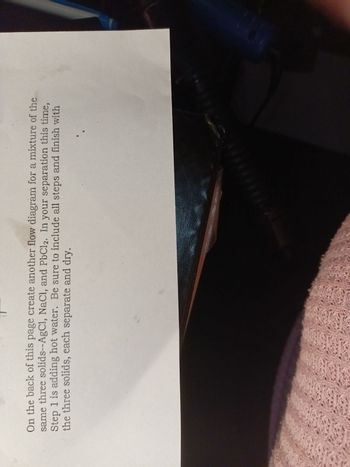Flow Diagram for Mixtures You are given a mixture of three solids: AgCl, NaCl, and PbCl2. The following information is important. NaCl is soluble in hot and cold water. AgCl is insoluble in hot or cold water. PbCl2 is soluble in hot water and insoluble in cold water. Using this information, complete a flow diagram for their separation. NaCl, AgCl, PBC12 Step 1. Add cold water and filter. Pocla Step 3. Add hot water and filter Step 2. Heat to dryness. Step 4. Dry Step 5. Cool solution and filter. Step 6. Dry On the back of this page create another flow diagram for a mixture of the same three solids--AgCl, NaCI, and PbCl2. In your separation this time, Step 1 is adding hot water. Be sure to include all steps and finish with the three solids, each separate and dry.
Flow Diagram for Mixtures You are given a mixture of three solids: AgCl, NaCl, and PbCl2. The following information is important. NaCl is soluble in hot and cold water. AgCl is insoluble in hot or cold water. PbCl2 is soluble in hot water and insoluble in cold water. Using this information, complete a flow diagram for their separation. NaCl, AgCl, PBC12 Step 1. Add cold water and filter. Pocla Step 3. Add hot water and filter Step 2. Heat to dryness. Step 4. Dry Step 5. Cool solution and filter. Step 6. Dry On the back of this page create another flow diagram for a mixture of the same three solids--AgCl, NaCI, and PbCl2. In your separation this time, Step 1 is adding hot water. Be sure to include all steps and finish with the three solids, each separate and dry.
Chemistry
10th Edition
ISBN:9781305957404
Author:Steven S. Zumdahl, Susan A. Zumdahl, Donald J. DeCoste
Publisher:Steven S. Zumdahl, Susan A. Zumdahl, Donald J. DeCoste
Chapter1: Chemical Foundations
Section: Chapter Questions
Problem 1RQ: Define and explain the differences between the following terms. a. law and theory b. theory and...
Related questions
Question
100%
How do fill in the Flow Diagram for the Mixtures using the information presented?

Transcribed Image Text:Name queline Delgadillo
Flow Diagram for Mixtures
You are given a mixture of three solids: AgCl, NaCI, and PbCl2. The
following information is important.
Nacl is soluble in hot and cold water.
AgCl is insoluble in hot or cold water.
PbCl2 is soluble in hot water and insoluble in cold water.
Using this information, complete a flow diagram for their separation.
NaCl, AgCl, PBC22|
Step 1. Add cold water and filter.
Pocla
Pocla
Step 3. Add hỏt water
and filter
Step 2. Heat
to dryness.
Step 5. Cool solution
and filter.
Step 4. Dry
Step 6. Dry
On the back of this page create another flow diagram for a mixture of the
same three solids--AgCl, NaCI, and PbCl2. In your separation this time,
Step 1 is adding hot water. Be sure to include all steps and finish with
the three solids, each separate and dry.
Expert Solution
Step 1 Separating the three compounds:
Characteristics of three compounds:
1. NaCl is soluble in both hot and cold water .
Step I: when we add cold water to the mixture,
a. NaCl dissolves in the water.
b. AgCl and PbCl2 remains insoluble.
Hence, when we filter the solution, AgCl and PbCl2 are obtained as precipitate on filter paper but NaCl remains in filtrate (water) as NaCl (aq) .
Step 2: Now if we heat the filtrate to dryness, all the water evaporates but dry solid sodium chloride NaCl (s) is left behind.
Trending now
This is a popular solution!
Step by step
Solved in 3 steps with 1 images

Follow-up Questions
Read through expert solutions to related follow-up questions below.
Follow-up Question
How do I do this?

Transcribed Image Text:On the back of this page create another flow diagram for a mixture of the
same three solids--AgCl, NaCl, and PbCl2. In your separation this time,
Step 1 is adding hot water. Be sure to include all steps and finish with
the three solids, each separate and dry.
Solution
Knowledge Booster
Learn more about
Need a deep-dive on the concept behind this application? Look no further. Learn more about this topic, chemistry and related others by exploring similar questions and additional content below.Recommended textbooks for you

Chemistry
Chemistry
ISBN:
9781305957404
Author:
Steven S. Zumdahl, Susan A. Zumdahl, Donald J. DeCoste
Publisher:
Cengage Learning

Chemistry
Chemistry
ISBN:
9781259911156
Author:
Raymond Chang Dr., Jason Overby Professor
Publisher:
McGraw-Hill Education

Principles of Instrumental Analysis
Chemistry
ISBN:
9781305577213
Author:
Douglas A. Skoog, F. James Holler, Stanley R. Crouch
Publisher:
Cengage Learning

Chemistry
Chemistry
ISBN:
9781305957404
Author:
Steven S. Zumdahl, Susan A. Zumdahl, Donald J. DeCoste
Publisher:
Cengage Learning

Chemistry
Chemistry
ISBN:
9781259911156
Author:
Raymond Chang Dr., Jason Overby Professor
Publisher:
McGraw-Hill Education

Principles of Instrumental Analysis
Chemistry
ISBN:
9781305577213
Author:
Douglas A. Skoog, F. James Holler, Stanley R. Crouch
Publisher:
Cengage Learning

Organic Chemistry
Chemistry
ISBN:
9780078021558
Author:
Janice Gorzynski Smith Dr.
Publisher:
McGraw-Hill Education

Chemistry: Principles and Reactions
Chemistry
ISBN:
9781305079373
Author:
William L. Masterton, Cecile N. Hurley
Publisher:
Cengage Learning

Elementary Principles of Chemical Processes, Bind…
Chemistry
ISBN:
9781118431221
Author:
Richard M. Felder, Ronald W. Rousseau, Lisa G. Bullard
Publisher:
WILEY